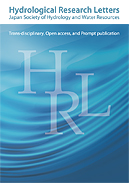
- Issue 4 Pages 28-
- Issue 3 Pages 14-
- Issue 2 Pages 7-
- Issue 1 Pages 1-
- |<
- <
- 1
- >
- >|
-
Nurul Fajar Januriyadi, So Kazama, Idham Riyando Moe, Shuichi Kure2018Volume 12Issue 3 Pages 14-22
Published: 2018
Released on J-STAGE: July 18, 2018
JOURNAL OPEN ACCESS
Supplementary materialThe purpose of this research is to assess the future flood risk in rapidly urbanizing cities under climate change. A flood inundation model and a flood damage costs model were employed to project the future flood risk. We employed the combinations of eight global climate models (GCMs) and three representative concentration pathways (RCPs) for precipitation to represent the climate change. Land-use change and land subsidence information were employed to represent the urban development effects. The expected annual damage costs (EADC) were also calculated to explain the severity of the flood risk. In addition, a global approach was used to estimate the asset values by comparing the common parameters (e.g. gross domestic production (GDP) or population). As a result, the combination of climate change and urban development amplified the mean future flood risk by 322% to 402% in 2050, with a 95% confidence interval. The results also show a large uncertainty of the future flood risk due to the future scenarios. These findings will assist policymakers in determining the investment for future flood prevention and mitigation.
View full abstractDownload PDF (2949K) -
Masaatsu Aichi, Kento Akitaya2018Volume 12Issue 3 Pages 23-27
Published: 2018
Released on J-STAGE: September 04, 2018
JOURNAL OPEN ACCESSThis study presents the analytical solution for a radial advection-dispersion equation for a steady-state flow field in a horizontal aquifer caused by a constant rate injection from a well, including the mechanical dispersion and molecular diffusion terms in addition to the retardation and first-order attenuation under a Robin-type boundary condition at the well. The derived analytical solutions were compared with finely-meshed finite difference solutions in steady-state and periodic steady-state problems with typical parameters. The results suggest that the analytical solution is exactly derived and ready for application. Comparisons with analytical solutions ignoring molecular diffusion suggest that the derived analytical solution should be used when the product of the decay constant and the retardation factor and the ratio of injection rate to diffusion coefficient are small. Comparisons with analytical solutions with Dirichlet-type boundary conditions confirmed that Robin-type boundary conditions should be used to exactly evaluate the concentration profile.
View full abstractDownload PDF (2469K)
- |<
- <
- 1
- >
- >|